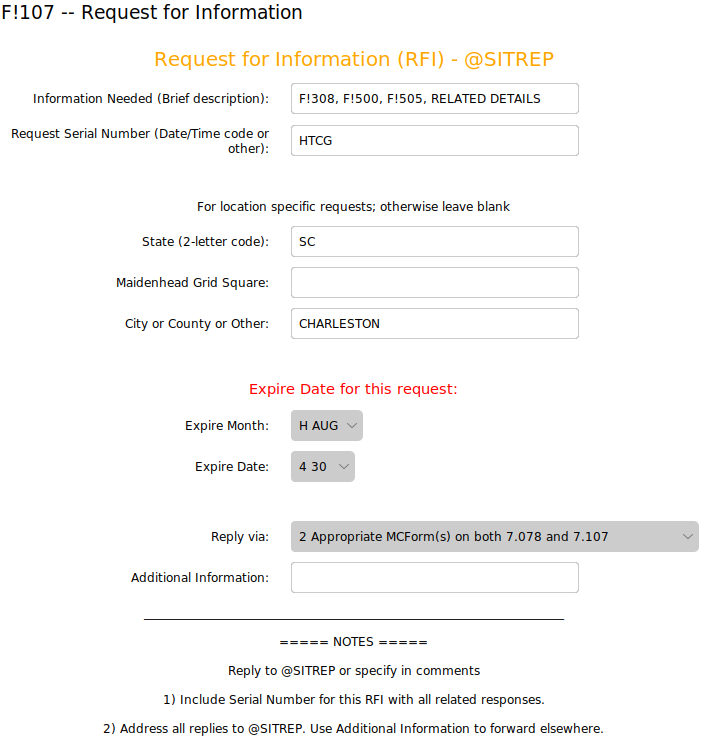
SitRepNet is focused on gathering information from a wide variety of stations, with JS8Spotter as the primary tool. From there, it can be compiled, analyzed, and turned into useful intel bulletins.
Every tool has a task, and JS8Spotter is uniquely qualified for efficiently soliciting and gathering information. Many bulletins created from that information are typically going to be longer than what the JS8 mode can efficiently handle. Short bulletins and brief summaries, yes, but more detailed bulletins are better handled using faster modes. That is where the Bulletin Distribution Net (BDN) comes in. Closely integrating SitRepNet and Bulletin Distribution Net is part of our long term goal.
If SitRepNet is the Input, then the BDN is the Output; what happens between Input and Output is described below, and some of it is still being built.
What bulletins are distributed?
First, let’s state the obvious – if you can read this on the internet, these bulletins are not going to be your primary news source. This is all about building a system to share news and situation reports in a grid-down situation, whether short term or long. The bulletins we distribute are part of the testing and refinement process. That said, we also do our best to make the bulletins useful and interesting.
The BDN started out distributing the National Intelligence Bulletin (NIB) when it was available. It is no longer available, so we will be distributing other bulletins. AmRRON produces their AIB every week, and has been doing so for years, so that may be on the distribution list. There are also other bulletins published by radio groups and by government agencies that we will use as appropriate.
One of our goals is to have a system in place that uses SitRepNet to request specific information, gather and compile that information, and then turn that into useful intel. A primary objective of SitRepNet is decentralization – plans do not include a rigid chain of command, or any kind of military or government style intel system, yet even a decentralized system must have a plan and tools in place for this to happen. The information being gathered is all sent “in the open” for anyone to use. This is very much a DIY project, so ideally, multiple people will do their own analysis, come to their own conclusions, and then share that among all interested amateur radio operators. Think of it as crowd-sourced intelligence gathering.
How would SitRepNet gather information and use it?
Let’s look at an example. Let’s say that we are hearing radio chatter about “something” happening in the area of Charleston, SC, and we need to know more. What happens next?
- We use JS8Spotter to send a Request for Information (RFI) form (F!107) with the following fields:
- [IN] (Information Needed) – F!308, F!500, F!505, RELATED DETAILS
- [SN] (Serial Number – typically a JS8Spotter Date/Time code) – HTCG
- [ST] (State) – SC
- [GR] (Grid – not used in this example) –
- [CT] (City, County, Other) – Charleston
- EXPIRE MONTH (Expire date avoids using stale news) – <AUG>
- EXPIRE DATE – <30>
- REPLY VIA – <Appropriate MCForm(s) on both 7.078 and 7.107>
- [AI] (Additional Information – not used in this example) –
- This RFI gets sent out on 7.078 and 7.107 multiple times over a 48 hour period, and is also available from @SITREP using the JS8Spotter Expect system by sending @SITREP E? F!107.
- Stations in and around Charleston complete F!308, F!500, and F!505. Relevant information that doesn’t fit into one of the MCForms is sent as text. The Serial Number (HTCG) is included in the comments field so the reports get routed to the correct RFI.
- Replies to this RFI are sent to @SITREP on 7.078 and 7.107 at intervals. SitRepNet stations running 24/7 receive the replies and make sure they are routed to the originator of the RFI if not already received.
- A bulletin is created using this information, or it is included in a regularly scheduled bulletin.
- How this step is accomplished will vary widely, depending on who is doing it. Remember this is a decentralized DIY operation. We can provide guidance and tools, but there is no “Central Command” to make it happen.
- The bulletin is sent out through the Bulletin Distribution Net. Brief report summary may be sent out using JS8Spotter.
⚑ Below is what the receiving stations see when they view this F!107 Request for Information.

This entire F!107 RFI is sent as:
F!107 H42 IN[F!308, F!500, F!505, RELATED DETAILS] SN[HTCG] ST[SC] CT[CHARLESTON] #HTWZ
Can this really be scaled up?
In any decentralized system, there are very real limitations on how well it can scale up to a high volume operation, and this is no exception. The question then becomes, “Will there be a large number of stations in operation after a week or so of a full grid-down situation?” We’re just guessing, of course, but the answer is “probably not” – at least not large enough to push this to the breaking point. If there is a large number of stations in operation, and those stations are experienced using HF digital modes, then that will be a good problem to have. We’ll just have to wait and see what happens. In the mean time, we practice, we test, we modify, and we give it our best effort.
